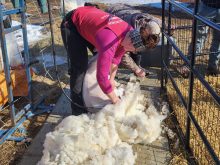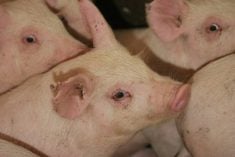When the snow goes, the anthrax comes.
Livestock producers in Saskatchewan’s central and northeastern regions are being told that if they or their neighbours or their neighbours’ neighbours had anthrax last year, then they better plan to vaccinate against the bacterial infection.
Wet soil conditions helped spawn the largest outbreak of anthrax in Canadian history last year, and veterinarian Eldon Pederson of Melfort, Sask., found himself in the middle of the outbreak, selling more than 60,000 doses of vaccine.
“When I graduated from university I expected that the last time I’d ever have to deal with anthrax was on an exam in school,” he said.
Read Also

Charges laid after cattle theft
Saskatchewan RCMP lay two charges against a man after six cattle went missing.
He graduated in 1976 and until last year he was right.
Central and northeastern Saskatchewan was hardest hit, but southeastern Manitoba had more cases than previously experienced and Alberta had an isolated case in a Bonnyville bison herd.
Sandra Stephens of the Canadian Food Inspection Agency said isolated cases are usually all that occur in Canada.
“This was very unusual. The conditions must have been just right, or wrong,” she said.
Stephens said producers should consult with veterinarians and if told their herds are at risk, they should heed the warning to vaccinate.
“We are seeing in some of those at-risk areas conditions that will continue to pose a threat to stock,” she said.
“There was nine or 10 inches of rain in some areas of northeastern Saskatchewan last fall. They have snow and more is predicted.”
In saturated soil, anthrax spores percolate up from deep in the ground where they can remain for decades. Once at the soil’s surface, they float in pooled water. As the water evaporates they concentrate and become available in the mud to grazing livestock. Animals are attracted to the lush, mid or late season plants in muddy areas, and when they eat those plants they take a little soil and spores along for an often fatal ride.
Pederson said bulls dig in the mud and cattle wade into riparian areas, sinking deep into the soil as the pools evaporate.
“We can’t say for certain what caused last year’s outbreak, but it’s likely not going to disappear as fast as it appeared,” he said.
This year he has ordered 17,700 doses of the vaccine.
“Last year we had producers driving in from all over to get vaccine. This year the vaccine will be available more broadly.”
Vaccinations will begin in earnest in May, about a month before cattle head out to pasture.
Stephens said the vaccine will need that month to create proper levels of immunity.
Pederson said it appears that older calves can likely create an effective immunity to the disease after vaccination, but calves younger than eight weeks may not create enough antibodies because their immune systems are still developing and under the initial effect of the cow’s colostrums.
“We had a lot of cases up here, but we may have had more than were officially reported,” he said.
“Just because you didn’t have an official report of the disease doesn’t mean it wasn’t around.”
He said part of the problem might have been not finding all of the animals that died in the first few days of the outbreak.
Federal producer compensation programs won’t pay unless anthrax can be cultured from the carcass. If several days pass the bacteria may not be available for a successful culture, he added.
“As vets we weren’t allowed to do any postmortems last year, after that first one we found. If the carcass remained closed for a couple of days the bacteria are all killed by the decomposition. If that was the case there were none to culture and no compensation and no record of the cause,” he said.
“So don’t count on the fact that you didn’t have it and your neighbour not having it as being a sign that isn’t around either.”
The vaccine has a three-year lifespan from the date of manufacture, so unlike many products the $2 to $3 per dose leftovers can be injected the following season.
















